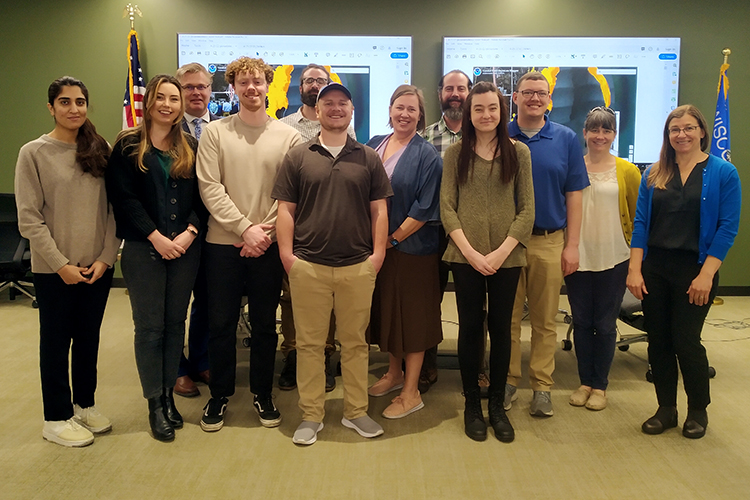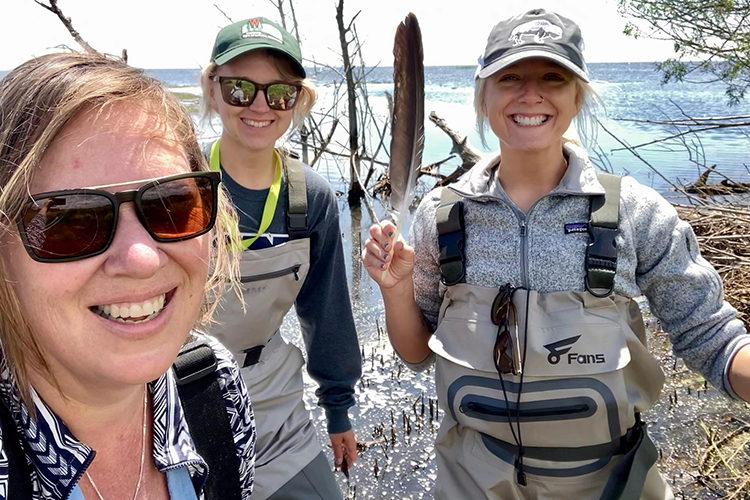Science is anything but a solitary endeavor. Addressing complex environmental issues requires an interdisciplinary approach, as students who took the spring “Freshwater Practicum” at the University of Wisconsin-Milwaukee learned.
The course simulated what it is like to work for a water consulting firm and brought together graduate students specializing in water science, atmospheric and climate science, environmental engineering, geographic information science and social sciences.

Students logged a combined 1,400 hours for their client: the Wisconsin Department of Natural Resources. One team analyzed how climate change is impacting Great Lakes coastal resiliency in Oconto, Brown and Manitowoc Counties. Another created a framework to help the WDNR equitably distribute new funds from the Bipartisan Infrastructure Law to improve drinking water infrastructure. The teams wrote reports and presented their findings and recommendations to the agency.
Sydney Morgan, a graduate student in the UWM College of Engineering and Applied Science, led the team working on drinking water infrastructure. After extensively analyzing past funding distribution, public outreach programs, public data about drinking water and EPA environmental data, the team provided the DNR with several administrative, mapping and public outreach recommendations for distributing new funds in a way that promotes environmental justice.
“The Bipartisan Infrastructure Law has provided states the opportunity to reevaluate their infrastructure funding distribution systems, and it was amazing to get to be a part of that process,” she says. “Many of us on my team, including myself, plan to work in environmental consultancies in some capacity in our careers. This project provided on-the-ground training in consulting, as well as a glimpse into what it is like working with a government agency. It never felt like just a school project.”
Their report included a recommendation to update the state’s definition of a “disadvantaged community” to be more inclusive, ways to make the funding application process more accessible, and recommendations for improving the state’s mapping capabilities. The WDNR is already considering these recommendations to improve their public outreach.
“Environmental justice considerations are a priority for the DNR and for the new federal Bipartisan Infrastructure Law funding. We have already incorporated additional scoring criteria to better evaluate disadvantaged communities,” says Michael C. Thompson, secretary’s director for southeastern Wisconsin at the WDNR. “We have been having regular discussions with community and environmental groups, and we envision the students’ report will further inform this work.”
This is exactly the kinds of hands-on learning that Melissa Scanlan, a School of Freshwater Sciences’ professor and the director of the Center for Water Policy, envisioned when she designed the course.
“The Freshwater Practicum allows students to apply their knowledge and skills to solve real-world problems and that can be really powerful for graduate students,” she says. “They had to learn to be effective communicators across disciplines to accomplish something together that none of them could do alone. That’s a rare and valuable skillset.”
Dillon Blount, a PhD student in the Atmospheric Science program, found this to be true. His team examined the increasing effects of climate change on coastal regions. Team members created maps of at-risk structures in Brown, Manitowoc and Oconto counties that may be impacted by future lake changes, bluff erosion and lake flooding. They also evaluated how the WDNR can perform a risk analysis to use their limited resources most efficiently and proactively.
“This project built my leaderships skills, as a team manager, which is valuable in a future career. It also taught valuable communication and writing skills that proved useful in a group setting,” he says. “I want prospective students to know that this is a learning experience. You may be getting a grade, but you are also making career connections that will be useful in the future.”
Not only did students expand their skillsets, but they met more than a dozen contacts in the private and public sector. After their presentations, Thompson offered advice to the students about how to search for and land a dream job at the WDNR.
Teammate Kiara Caldwell, a master’s student in the School of Freshwater Sciences, is interning with the WDNR’s Lakes and Rivers Bureau of Water Quality this summer. Before the practicum began, she had applied to be a Water Resources Management Fellow. Working with the WDNR during the practicum provided valuable experience for her internship.
“The technical report we created [in the course] was referenced back to me by someone I met at the Office of Great Waters on my second day!” Caldwell says. “They talked about modeling their own work in Door County after the structure we built in our report.”
